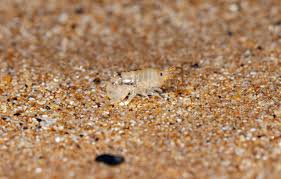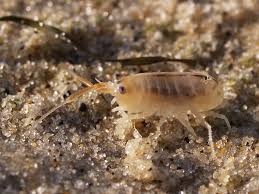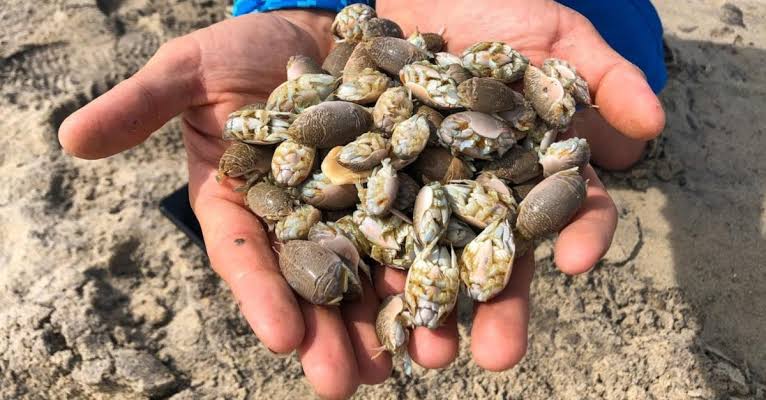Sand fleas, scientifically known as Tunga penetrans, are tiny creatures that dwell in sandy environments. These minuscule parasites are not actual fleas but rather belong to the group of fleas called “chigoe fleas.” They are adept at burrowing into the skin of warm-blooded hosts, causing discomfort and sometimes health issues.
These creatures measure only a few millimeters in size, making them barely visible to the naked eye. Despite their small stature, the impact of sand fleas can be significant. Tunga penetrans typically inhabit coastal and sandy regions, where they find optimal conditions for their life cycle.
The life cycle of sand fleas begins in the sand, where their eggs are laid. Once hatched, the larvae seek out suitable hosts, such as mammals, to burrow into. Humans can unintentionally become hosts when walking barefoot on infested sandy terrain. The female sand flea burrows into the skin, usually targeting areas with thinner skin layers, like the feet and ankles.
As the sand flea burrows into the skin, it causes irritation and the formation of a small, painful bump known as a “furuncle.” This discomfort is a result of the flea’s feeding and reproductive activities. If left untreated, the infestation can lead to more severe complications, including infections.
Preventing sand flea bites involves avoiding infested areas, wearing protective footwear, and using insect repellent. In affected regions, public health measures are crucial to control the prevalence of these parasites. Education about the risks and proper hygiene practices can contribute to minimizing the impact of sand fleas on communities.
However, while sand fleas may be tiny, their presence can pose a considerable nuisance and health risk. Understanding their habits, taking preventive measures, and promoting awareness are essential steps in managing and mitigating the impact of these microscopic yet troublesome creatures.
Read Also: Manx Cats Breed Description and Complete Care Guide
Animals Affected by Sand Fleas (Tunga penetrans)

Sand fleas primarily affect warm-blooded animals, with a notable impact on humans, domestic pets, and wildlife. The parasitic nature of sand fleas can lead to various health issues and discomfort among affected animals.
1. Humans: Humans are frequent hosts for sand fleas, especially in coastal and sandy regions. Walking barefoot in infested areas increases the risk of sand flea bites. The parasites commonly burrow into the feet and ankles, causing irritation, itching, and potential infections if left untreated.
2. Domestic Pets: Dogs, cats, and other domestic animals can also fall victim to sand fleas. These parasites may burrow into the skin of pets, causing similar discomfort and skin irritations. Flea control measures, such as topical treatments and regular grooming, are essential to prevent and manage infestations in pets.
3. Wildlife: Various wild animals, especially those inhabiting sandy environments, can be affected by sand fleas. This includes small mammals, rodents, and other creatures with exposed skin. While the impact on wildlife may not always be well-documented, sand fleas have the potential to disturb the ecological balance in affected regions.
4. Livestock: Livestock in sandy regions may also be susceptible to sand flea infestations. Hoofed animals, such as cattle and goats, can experience discomfort and skin issues if infested. Monitoring and managing sand flea populations in areas where livestock graze are crucial for the well-being of these animals.
Understanding the range of animals affected by sand fleas highlights the importance of comprehensive pest control measures. Efforts to protect both human and animal populations involve preventive strategies, awareness campaigns, and the application of suitable insecticides in infested areas. By addressing sand flea infestations across various species, communities can work towards creating healthier and more comfortable environments for both humans and animals alike.
Damages Caused by Sand Fleas

Sand fleas, through their parasitic activities, can cause various damages to both humans and animals. These damages range from mild skin irritations to more severe health complications. Here are some of the potential damages caused by sand fleas:
1. Skin Irritations: The primary impact of sand fleas is skin irritation. When these tiny parasites burrow into the skin, they cause localized discomfort, itching, and the formation of painful bumps known as furuncles. Scratching the affected areas can exacerbate the irritation and lead to secondary infections.
2. Infections: Continuous scratching of sand flea bites can break the skin, creating openings for bacteria to enter. This increases the risk of infections, which can manifest as redness, swelling, and pus formation. If left untreated, these infections can spread and cause more serious health issues.
3. Ulceration: In severe cases, particularly with prolonged infestations, sand fleas can lead to ulceration at the site of penetration. This occurs when the parasites cause damage to the skin and underlying tissues, resulting in open sores that may be painful and prone to infection.
4. Secondary Complications: Sand flea bites can trigger allergic reactions in some individuals, leading to secondary complications such as hives, swelling, and respiratory issues. People with sensitivities to insect bites may experience more severe reactions.
5. Impact on Livestock and Wildlife: Livestock and wildlife can also suffer damages from sand flea infestations. Animals may exhibit signs of distress, reduced productivity, and changes in behavior. In severe cases, sand fleas can contribute to skin diseases and compromise the overall health of affected animals.
6. Psychological Impact: Constant itching, pain, and discomfort caused by sand flea bites can have a psychological impact, affecting the mental well-being of individuals. Anxiety and stress may arise due to the persistent irritation and the challenges of managing infestations.
Addressing damages caused by sand fleas involves a multi-faceted approach, including proper hygiene practices, use of insect repellents, and targeted pest control measures. Additionally, early detection and treatment of sand flea bites are crucial in preventing complications and minimizing the overall impact on both human and animal populations in affected areas.
Read Also: Oriental Shorthair Cat Breed Description and Complete Care Guide
Control and Preventive Measures

Controlling and preventing sand flea infestations involves a combination of proactive measures to reduce exposure and targeted strategies to manage existing populations. Here are some effective control and preventive measures:
1. Protective Clothing: Wearing closed shoes and long clothing, especially in areas prone to sand fleas, can minimize skin exposure and reduce the risk of bites. This is particularly important when walking in sandy environments.
2. Footwear: Encouraging the use of footwear, such as sandals or closed shoes, helps prevent sand fleas from burrowing into the skin. This is crucial in areas where the parasites are prevalent.
3. Insect Repellents: Applying insect repellents containing DEET or other recommended ingredients can be effective in deterring sand fleas. Regular reapplication, especially after sweating or swimming, enhances the repellent’s efficacy.
4. Environmental Management: Modifying the environment to make it less conducive for sand fleas is essential. This may include clearing debris, maintaining cleanliness, and avoiding accumulations of organic matter where sand fleas thrive.
5. Pest Control Measures: In infested areas, targeted pest control measures can help manage sand flea populations. This may involve the use of insecticides specifically designed for flea control. It’s important to follow safety guidelines when applying these substances.
6. Personal Hygiene: Regular bathing and maintaining good personal hygiene can help prevent and manage sand flea infestations. Thorough cleaning of the skin after potential exposure reduces the chances of bites leading to complications.
7. Awareness Campaigns: Educating communities about the risks associated with sand fleas and promoting preventive measures can contribute to a collective effort in reducing infestations. This includes providing information about proper footwear, hygiene practices, and recognizing the signs of infestation.
8. Pet Care: Implementing flea control measures for pets, such as regular grooming and the use of vet-recommended flea prevention products, helps protect them from sand fleas. This, in turn, reduces the risk of humans contracting the parasites from infested pets.
9. Monitoring and Early Treatment: Regularly monitoring for signs of sand flea infestations and seeking prompt medical attention for bites can prevent complications. Early treatment, including proper wound care and use of prescribed medications, is crucial for minimizing damages.
By combining these measures, communities and individuals can create a more resilient defense against sand fleas. A holistic approach that addresses both environmental factors and personal habits is key to effective control and prevention of sand flea infestations.
Frequently Asked Questions (FAQs) About Sand Fleas (Tunga penetrans)
1. Q: What are sand fleas, and why are they called fleas?
A: Sand fleas, scientifically known as Tunga penetrans, are tiny parasites found in sandy environments. Despite their name, they are not true fleas but belong to the chigoe flea group. They are called fleas due to their small size and ability to cause discomfort similar to other flea bites.
2. Q: How do sand fleas affect humans?
A: Sand fleas affect humans by burrowing into the skin, usually targeting areas with thinner skin layers, such as the feet and ankles. This can lead to skin irritation, itching, and the formation of painful bumps. If left untreated, complications such as infections and ulceration may occur.
3. Q: Can pets be affected by sand fleas?
A: Yes, pets, including dogs and cats, can be affected by sand fleas. These parasites may burrow into the skin of pets, causing discomfort and skin irritations. Regular grooming and the use of vet-recommended flea prevention products can help protect pets.
4. Q: How can I prevent sand flea bites?
A: Preventive measures include wearing closed shoes and long clothing, using insect repellents, and avoiding walking barefoot in sandy areas. Environmental management, such as clearing debris and maintaining cleanliness, also reduces the risk of sand flea exposure.
5. Q: What are the symptoms of sand flea bites?
A: Symptoms include localized skin irritation, itching, and the formation of painful bumps called furuncles. Continuous scratching can lead to infections and, in severe cases, ulceration. Allergic reactions may occur in some individuals, causing hives and swelling.
6. Q: Are sand fleas found worldwide?
A: Sand fleas are primarily found in sandy environments, especially in coastal regions. While they are more prevalent in tropical and subtropical areas, they can be found in various parts of the world where sandy conditions exist.
7. Q: How can I treat sand flea bites?
A: Treatment involves cleaning the affected area, avoiding scratching, and applying antiseptic ointments. In cases of infection or severe reactions, seeking medical attention is recommended. Prescription medications may be necessary for more advanced infestations.
8. Q: Can sand flea infestations be controlled?
A: Yes, sand flea infestations can be controlled through a combination of preventive measures and targeted pest control strategies. This includes environmental management, insecticide use, and raising awareness in affected communities.
9. Q: Are sand fleas harmful to wildlife?
A: Sand fleas can affect wildlife, especially small mammals and rodents, by burrowing into their skin. While the impact on wildlife may vary, it can contribute to skin diseases and compromise the overall health of affected animals.
10. Q: Is there a vaccine or specific treatment for sand flea infestations?
A: Currently, there is no specific vaccine for sand flea infestations. Treatment involves addressing symptoms, practicing good hygiene, and seeking medical attention for severe cases. Preventive measures remain crucial in avoiding infestations.
Read Also: Sheep 101: Wool Production Complete Guide

